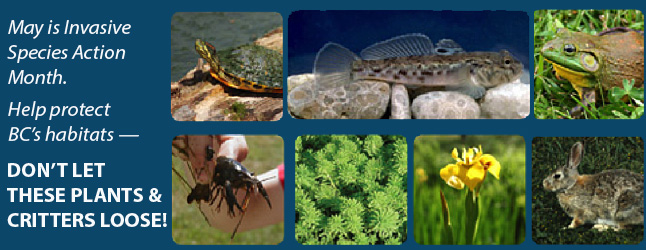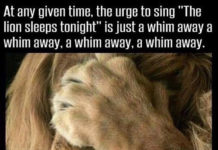
May has been officially proclaimed Invasive Species Action Month in BC and to mark this milestone the Columbia Shuswap Invasive Species Society (CSISS) is sponsoring a number of free workshops that can bring you up to date on the animals and plants that threaten our native creatures and habitats.
On May 10 CSISS is holding an Invasive Species Workshop at the Community Centre from 10 am – noon and from 1 pm – 4 pm. Similar workshops are being held on May 2 in Salmon Arm, May 11 in Sicamous and May 30 in Golden. Please click here for more information about those workshops.
What’s more the Invasive Species Council of British Columbia is publishing a story on a different subject each week during Invasive Species Action Month. each article will be posted on The Current. Here’s the first article:
Don’t let it loose!
Invasive species are plants, animals or other organisms that are not native to BC, and have serious impacts on our environment, economy and society. Invasive species can out-compete native species for food and space, damage ecosystems, disrupt food sources and introduce parasites and disease. They also harm local economies by discouraging recreation, decreasing property values, and interfering with navigation and water control structures. Invasive species cost British Columbia and Canada billions of dollars per year. Some of the most serious invasive species were originally sold as pets or plants for water gardens and aquariums.
Water gardeners, aquarium and terrarium owners can select from a variety of aquatic plants, invertebrates, reptiles and fish. Unfortunately, some of these exotic species have the potential to become invasive. Pets that become too much for an owner to care for are sometimes let loose into nearby water or woods.
Prospective pet owners need to understand the life cycles and needs of exotic pets before considering buying or adopting one. And if you still end up with a bully in your aquarium or a red-eared slider turtle that has outgrown its tank, be aware that letting plants and animals loose into the wild is not an appropriate solution.
Releasing pets into the wild is both inhumane and dangerous
Some people believe that when they don’t want their pets any longer, the best thing to do for the animal is to release it into the wild. However, this is cruel, dangerous to the environment, as well as illegal.
Most pets don’t survive in the wild – some die by being killed by predators or hit by cars, and others die of starvation. It is inhumane to release an animal into an environment it is not accustomed to. Releasing a pet into an unsuitable habitat is also considered animal cruelty and charges can be laid (BC SPCA).
Some exotic pets are able to thrive and reproduce in their new environment. Once established, they can take over their new habitat, reducing native populations and changing the structure of the ecosystem. Even if your aquatic pet is known to be native to the local environment, it should still never be released, as it may introduce diseases or invasive parasites into the local ecosystem..
BC’s ‘pet’ invasives…
British Columbia is now home to several introduced invasive pet and plant species, including:
- Red Eared Slider Turtle:
- American Bullfrog;
- Goldfish;
- Eurasian Milfoil;
- Parrot Feather;
- European Rabbit;
- Brazilian Elodea; and
- Koi Carp.
Never let your pet loose!
Never release your plants and animals into the wild or dump aquariums or water garden debris into rivers, streams, lakes or storm sewers!
What should I do instead?
- Contact the place where you purchased the animal to see if they will take it back.
- Contact local science centers, zoos or aquariums to see if they can use the animal for educational purposes.
- Dry and freeze unwanted aquatic plant material and add it to non-composted trash.
- Report sightings to your Regional Invasive Species Committee. Report ALL sightings of invasive mussels to the B.C. Conservation Officer Service (RAPP): 1-877-952-7277
- If all else fails, have a qualified veterinarian euthanize the animal in a humane manner; it’s far kinder than letting it starve to death in the wild or destroy the homes of native animals and plants.
Resources:
- Don’t Let it Loose Rack Card (PDF)
- Don’t Let it Loose Fact Sheet (PDF)
- Youth Aquarium Poster Activity for Grade 3-5 (PDF)
- Inter-Ministry Invasive Species Working Group – List of Priority Invasive Species and Factsheets



